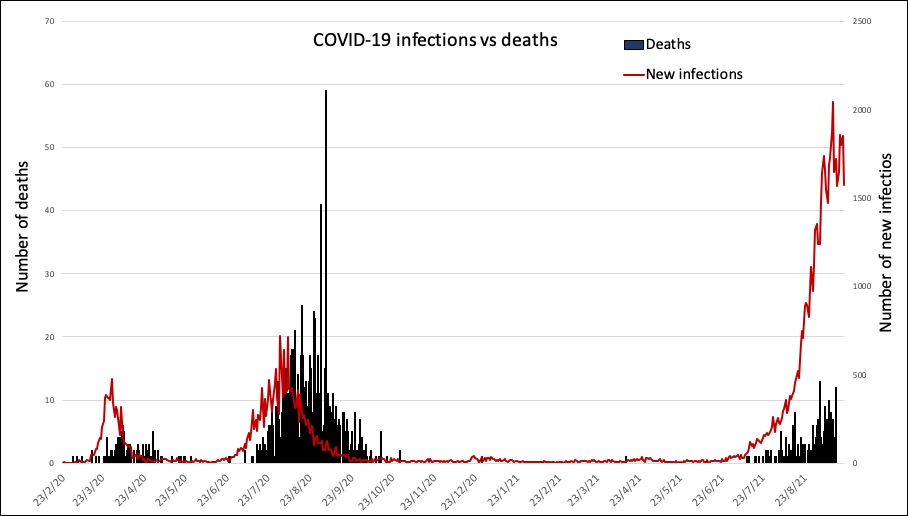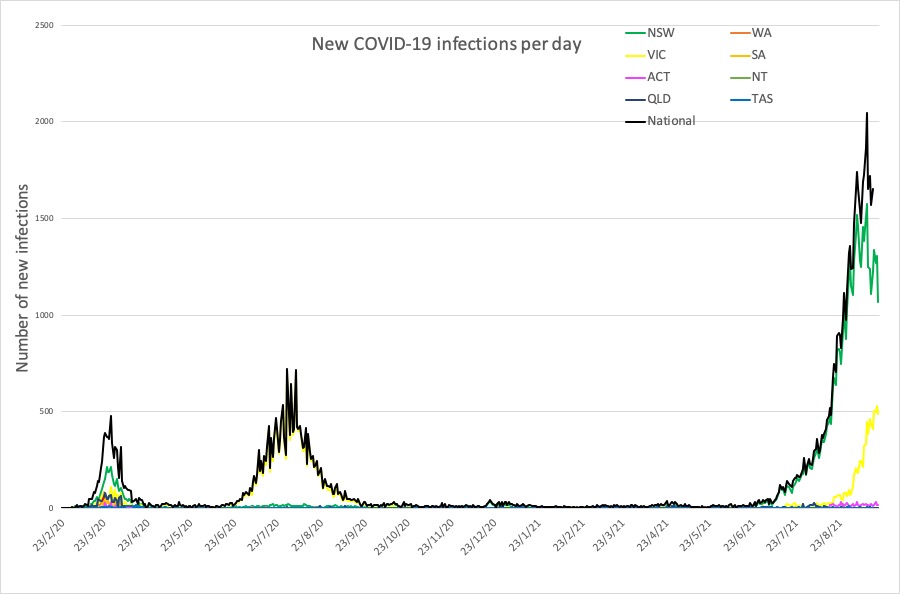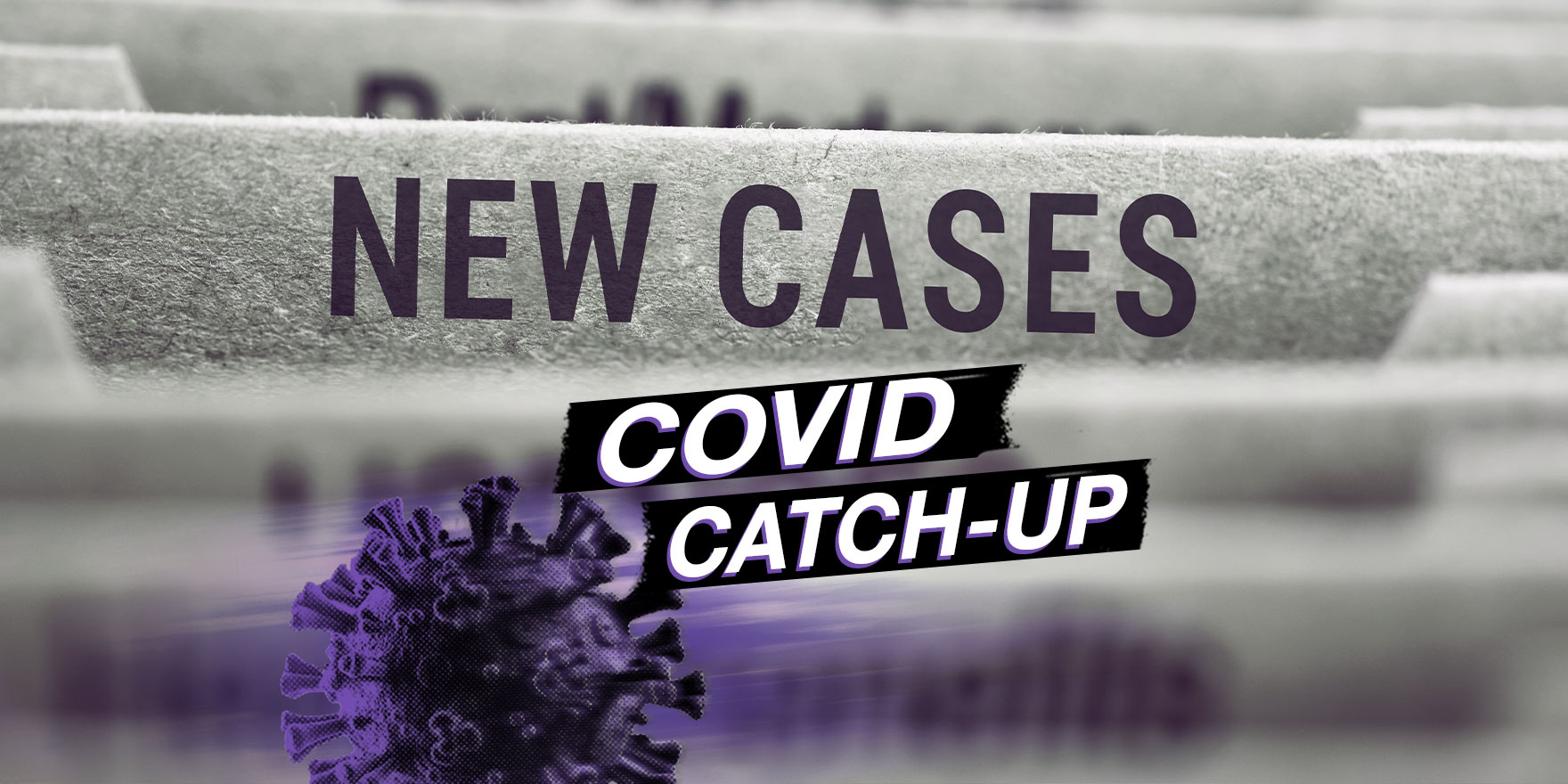And unvaccinated people have 11 times the risk of death.
Welcome to The Medical Republic‘s Covid Catch-Up.
It’s the day’s covid-19 news in one convenient post. Bianca Nogrady is taking a well-earned fortnight off, so for now please email penny@medicalrepublic.com.au with any tips, comments or feedback.
20 September
- The Doherty Institute has updated its modelling, recommending cases be strongly suppressed until 80% vaccination of adults is achieved
- The AMA has responded to National Plan in light of the Doherty update
- Unvaccinated people in the US have been dying at 11 times the rate of vaccinated people
- An FDA advisory panel has recommended against mass booster shots
- Delta does not cause worse illness in children and their covid after-effects appear to be limited, says the Murdoch Children’s Research Institute
- Infections vs deaths in Australia
- The latest covid infection numbers from around Australia
The Doherty Institute has performed a sensitivity analysis on its modelling, which informs the National Plan to transition the covid response, in light of case numbers that far exceed their original assumptions.
At a briefing yesterday, Professor Jodie McVernon said the team had rerun its models using seeding numbers in the hundreds and thousands, instead of the original tens, and found that their conclusions remained largely robust.
However, winding back public health safety measures at only 70% adult vaccination starting with daily cases in the thousands, with only partially effective testing, tracing, isolation and quarantine (TTIQ), could lead to bigger and earlier outbreaks, compared with waiting until 80% coverage. The team therefore recommends maintaining “medium restrictions” until that higher target is reached.
Professor McVernon noted that the modelling was was an “abstraction”, modelling a single national epidemic, but in reality “we see these things play out locally. So … jurisdictions should aim to really optimise coverage in small pockets and populations, because we’ve seen elsewhere, where there are pockets of under-immunisation infections can still spread.”
At risk of stating the obvious, Professor James McCaw said that for the currently covid-free states, “the best way for them to make a transition is to get vaccination rates as high as quickly as possible”.
While the virus would eventually establish itself in those states, “the higher the vaccine coverage, the longer that will take, and the less the consequence once it gets there: it will spread more slowly, it will be more controllable, everything will be better off.
“So, the strategy for those states is still basically the same as the strategy for a state like New South Wales, which is: increase vaccination rates as quickly as possible.”
The team said TTIQ in a covid-zero context – “assigning literally hundreds of contact tracers to a single case” – was labour-intensive and unsustainable, and could be scaled back to use resources more effectively to suppress case numbers.
Professor McVernon said adding 12-15-year-olds to the vaccine target did not make a large difference to the results of the modelling.
The AMA’s Federal Council released a statement yesterday in response to the National Plan, warning governments not to rely too heavily on vaccination and to act cautiously when easing restrictions.
Among a list of recommendations, it says restrictions should be relaxed one by one, with a “pause and assess” period each time to ensure control is maintained, and that jurisdictions should be prepared to reinstate restrictions.
Vaccination targets needed to apply across all populations, including Indigenous communities and remote areas, AMA president Dr Omar Khorshid said, “because the Plan is only as good as the vaccination rates in those vulnerable communities”.
He said the Doherty update showed the need for caution even without taking into account the impact on hospitals, which were already under pressure.
“We need to do everything we can to avoid our hospitals collapsing from opening up too early. We need planning, not just around ICU beds, but around staffing and how the primary health sector, including GPs, can support critical covid care. We don’t want to see the healthcare system become the handbrake on the economy and our ability to open up,” Dr Khorshid said.
Unvaccinated Americans have died at 11 times the rate of the vaccinated since Delta became the dominant strain, according to one of several studies of CDC surveillance data summarised in the BMJ.
The vaccinated were also 10 times less likely to be hospitalised and five times less likely to be infected, according to the study, which covered more than half a million covid cases.
Before Delta, death rates in unvaccinated people were almost 17 times higher than in the vaccinated.
Protection against being infected with the virus has slipped further in the face of Delta than protection against hospital admission and death: “These figures represent declines in crude efficacy, for all vaccine types combined, from 94% to 91% for death, 92% to 90% for hospital admissions, and 91% to 78% for infection.”
Another study found vaccines were an estimated 89% effective at preventing hospital admission in adults under 75 but 76% effective in those over 75. The same study found Moderna was 92% effective on hospital admissions overall while Pfizer was only 77% effective.
In no doubt unwelcome news for US President Joe Biden, an FDA advisory panel has recommended against boosters for the whole population, but has recommended them for over-65s.
The Vaccines and Related Biological Products Advisory Committee voted 16 to 2 against giving a third dose of Pfizer to everyone 16 and over, but 18-0 in favour of boosting those 65+ and those at risk of severe covid – a group that has not yet been defined.
Mr Biden and the FDA commissioner Janet Woolcock announced in August that booster shots would be offered to everyone vaccinated eight months ago or more, and the administration had planned to start distributing them this week.
The WHO has condemned the idea of third shots in affluent nations when people in developing countries are yet to receive their first.
The Delta variant does not appear to cause worse illness in children and adolescents, according to the Murdoch Children’s Research Institute, even though it is causing more cases and hospitalisations through increased transmissions.
The MCRI released a research brief last week saying severe covid continued to be rare in the young, though more frequent in those with pre-existing health conditions, disadvantage, low socioeconomic or minority ethnic status.
This echoes the CDC head Rochelle Walensky, who told media last week that “Although we are seeing more cases in chidlren, and more overall cases, [studies have] demonstrated that there was not increased disease severity in children”.
Reports have come out of the US of overwhelmed paediatric ICUs, but notably these are in southern states where adult vaccination uptake is lower and precautions such as mask mandates are rarer.
“The main risks to children and adolescents’ health in this pandemic continues to be due to indirect effects on mental health, wellbeing and education, which are worsened by continued lockdowns and school closures,” the MCRI brief says.
The institute’s Dr Petra Zimmermann and Professor Nigel Curtis have also reviewed studies of long covid in children, and found the evidence reassuring as far as it goes, but too limited to base policy on.
In the majority of studies, “symptoms did not persist longer than 12 weeks … suggesting long covid might be less of a concern in children and adolescents than in adults”, they write.
However, the scarcity and limitations of the studies to date “mean the true incidence of this syndrome in children and adolescents remains uncertain. The impact of age, disease severity and duration, virus strain, and other factors on the risk of long covid in this age group also remains to be determined.”
This striking chart of infections vs deaths in Australia says it all about the effectiveness of vaccines:

NSW is cautiously wondering whether it’s too soon to feel relieved after registering its first sub-1000 day of new cases in almost a month, with 935, while Victoria’s numbers are still on the rise with 567.
Here are the latest covid infection numbers from around Australia to 9pm Sunday:
National – 85,629 with 1162 deaths
ACT – 742 (17)
NSW – 51,986 (1067)
NT – 204 (0)
QLD – 2015 (0)
SA – 898 (0)
TAS – 235 (0)
VIC – 28,456 (488)
WA – 1093 (1)



